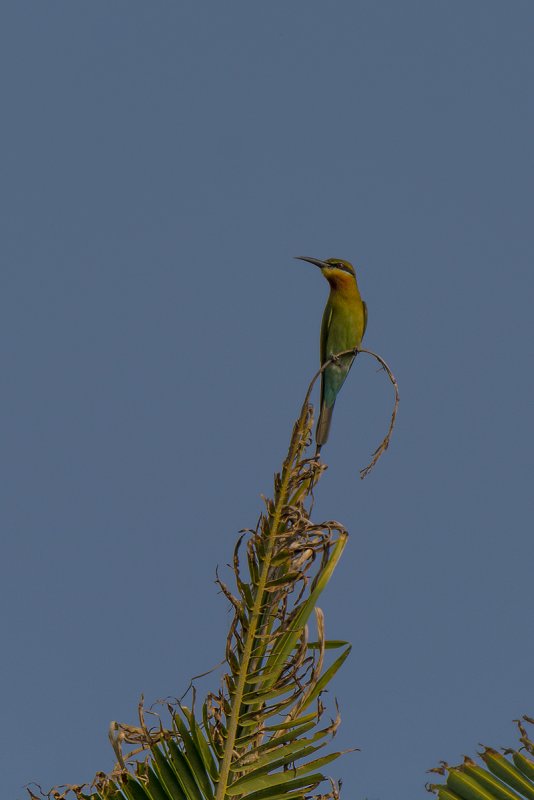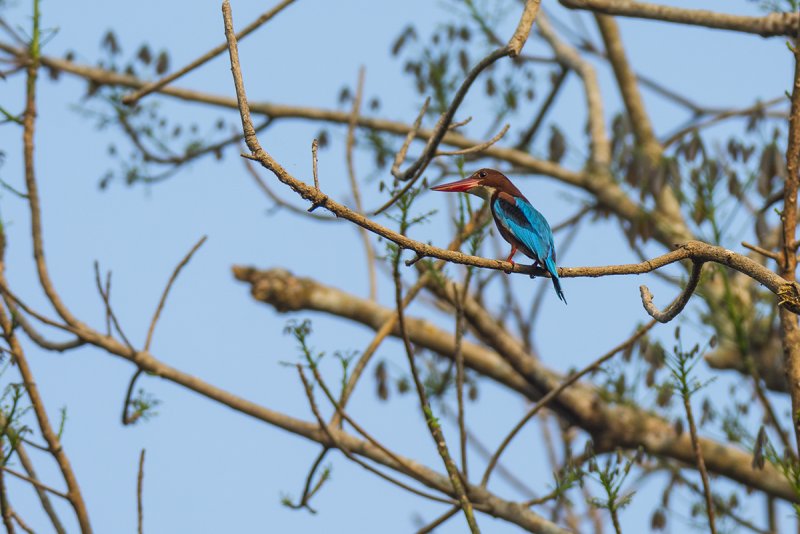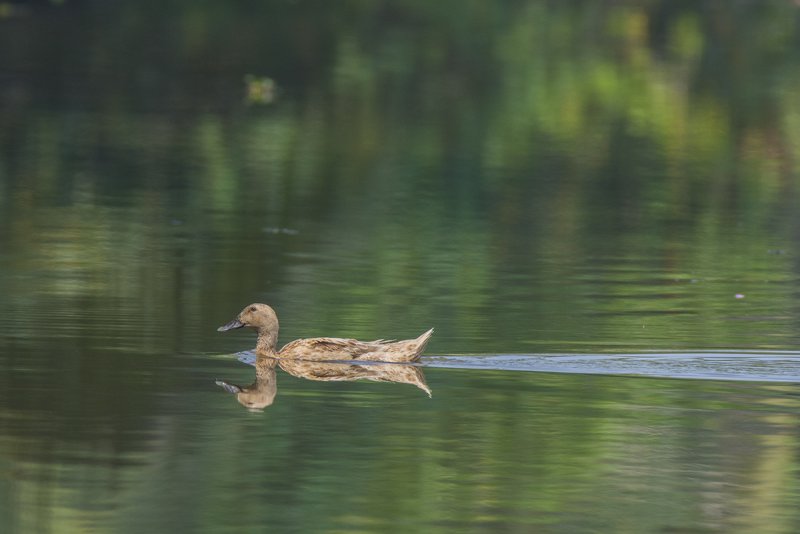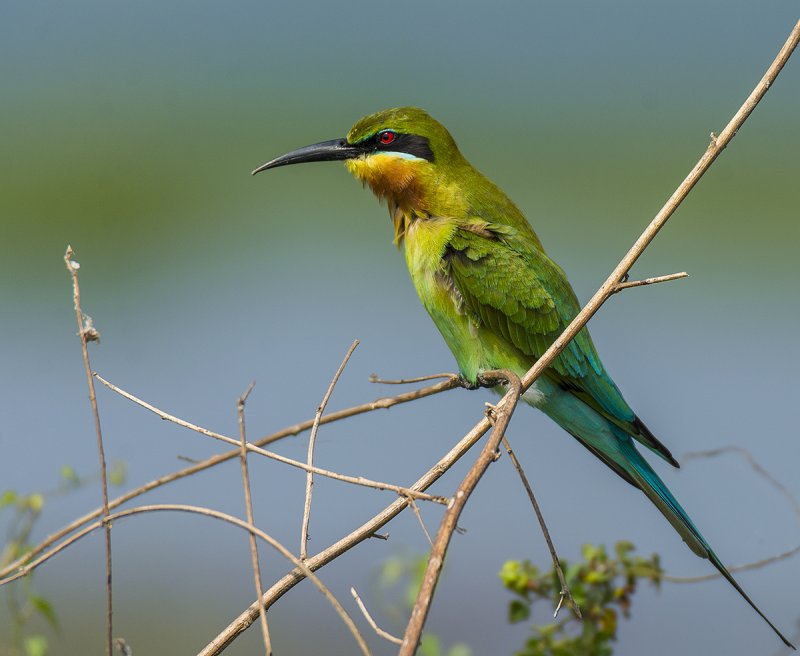Re: As the wheels roll and the shutters click…Travel reminiscences…
The bird sanctuary is quite small and there is a narrow pathway through the thick growth and tall trees. While we may sight some birds, photographing them may not be possible due to the tree heights, dense growth and lighting. Since the path is also very narrow - we have to walk in single file - it is difficult to move around the bird to get a good composition. We have to walk around 2 km to the end of the sanctuary and back the same way.
As we entered the sanctuary started our walk we were lucky to spot one young
Shikra/
little banded goshawk. We had this one in our sight for atleast 3 minutes till some people returning back disturbed it. The next bird that we saw was a Racket-tailed Drango, which we had to track hearing its call. Another bird that we saw looked like a male Asian Koel or a Indian Black bird. Not sure though. After coming out we saw a Blue-tailed Bee-eater. Though we have seen the more common Green Bee-eater and the chestnut Bee-eater earlier, this was our first Blue-tailed Bee-eater. Throughout our trip this time we were able to see more of them and take some beautiful photographs of them.
The Shikra (Accipiter badius) is a small bird of prey in the family Accipitridae found widely distributed in Asia and Africa where it is also called the little banded goshawk
The shikra is a small raptor (26–30 cm long) and like most other Accipiter hawks, this species has short rounded wings and a narrow and somewhat long tail. Adults are whitish on the underside with fine rufous bars while the upperparts are grey. The lower belly is less barred and the thighs are whitish. Males have a red iris while the females have a less red (yellowish orange) iris and brownish upperparts apart from heavier barring on the underparts. The females are slightly larger. The mesial stripe on the throat is dark but narrow. In flight the male seen from below shows a light wing lining (underwing coverts) and has blackish wing tips. When seen from above the tail bands are faintly marked on the lateral tail feathers and not as strongly marked as in the Eurasian sparrowhawk. The central tail feathers are unbanded and only have a dark terminal band. Juveniles have dark streaks and spots on the upper breast and the wing is narrowly barred while the tail has dark but narrow bands. A post juvenile transitional plumage is found with very strong barring on the contour feathers of the underside. The call is pee-wee, the first note being higher and the second being longer. In flight the calls are shorter and sharper kik-ki ... kik-ki.
Shikra Juvenile...




 The greater racket-tailed drongo (Dicrurus paradiseus) is a medium-sized Asian bird which is distinctive in having elongated outer tail feathers with webbing restricted to the tips. They are conspicuous in the forest habitats often perching in the open and by attracting attention with a wide range of loud calls that include perfect imitations of many other birds. It has been suggested that these imitations may help in the formation of mixed-species foraging flocks, a feature seen in forest bird communities where many insect feeders forage together. These drongos will sometimes steal insect prey caught or disturbed by other foragers in the flock. They are diurnal but are active well before dawn and late at dusk.
The greater racket-tailed drongo (Dicrurus paradiseus) is a medium-sized Asian bird which is distinctive in having elongated outer tail feathers with webbing restricted to the tips. They are conspicuous in the forest habitats often perching in the open and by attracting attention with a wide range of loud calls that include perfect imitations of many other birds. It has been suggested that these imitations may help in the formation of mixed-species foraging flocks, a feature seen in forest bird communities where many insect feeders forage together. These drongos will sometimes steal insect prey caught or disturbed by other foragers in the flock. They are diurnal but are active well before dawn and late at dusk.
In most of its range in Asia, this is the largest of the drongo species and is readily identifiable by the distinctive tail rackets and the crest of curled feather that begin in front of the face above the beak and along the crown to varying extents according to the subspecies. The tail with twirled rackets is distinctive and in flight it can appear as if two large bees were chasing a black bird.
Racket-tailed Drongo... a rear view showing its tail and the streaming rackets.
 Indian Blackbird or Asian Koel?
Indian Blackbird or Asian Koel?
 A Pond Heron...
A Pond Heron...
 Blue-tailed Bee-eater...
This species, like other bee-eaters, is a richly coloured, slender bird. It is predominantly green; its face has a narrow blue patch with a black eye stripe, and a yellow and brown throat; the tail is blue and the beak is black. It can reach a length of 23–26 cm, including the two elongated central tail feathers. Sexes are alike.
Blue-tailed Bee-eater...
This species, like other bee-eaters, is a richly coloured, slender bird. It is predominantly green; its face has a narrow blue patch with a black eye stripe, and a yellow and brown throat; the tail is blue and the beak is black. It can reach a length of 23–26 cm, including the two elongated central tail feathers. Sexes are alike.
Blue-tailed bee-eater displaying the blue on the tail and rump while perching
This is a bird which breeds in sub-tropical open country, such as farmland, parks or ricefields. It is most often seen near large waterbodies. Like other bee-eaters it predominantly eats insects, especially bees, wasps and hornets, which are caught in the air by sorties from an open perch.This species probably takes bees and dragonflies in roughly equal numbers. The insect that are caught are beaten on the perch to kill and break the exoskeleton. This habit is seen in many other members of the coraciiformes order.


 [to be cont.]
[to be cont.]























































![Smile [:)] [:)]](https://www.theautomotiveindia.com/forums/images/smilies/Smile.gif)
![Big Smile [:D] [:D]](https://www.theautomotiveindia.com/forums/images/smilies/Big%20Smile.gif)





























